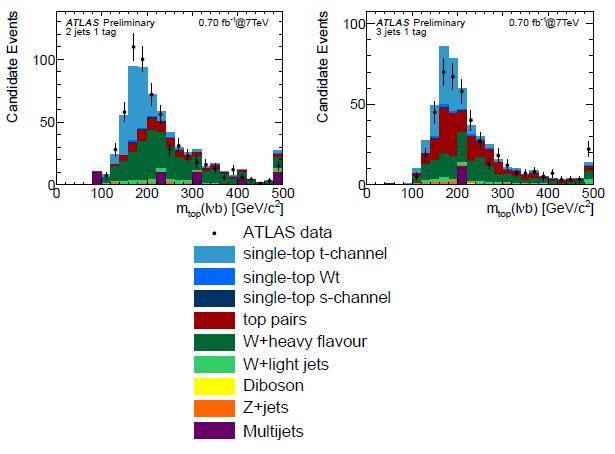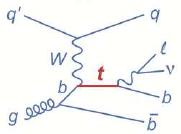Nowadays, the 7-TeV collisions of the Large Hadron Collider produce single top quarks at rates much higher than that of the 2-TeV Tevatron, enabling high-statistics studies of those reactions which surpass the precision of CDF and DZERO despite the still smaller total integrated luminosity available at CERN. More important than the total number of events produced (which you can always compute by multiplying the production cross section S by the integrated luminosity L as N = S L) is the fact that at 7 TeV the signal to noise ratio is larger, enabling the signal to "stand out" more clearly.

 The figure above shows the single-top signal (in blue) in the reconstructed top-quark mass distribution for events with two hadronic jets (left) or three hadronic jets (right). The number of jets one should see when single top is produced by the Feynman diagram on the left, the so-called "t-channel" production also known as "W-gluon fusion", is three, since the top quark (in red) is produced together with a b-quark, then decays into lepton, neutrino, and a further b-jet, but there is another quark leg coming from the initial state (the line in the upper part of the diagram).
The figure above shows the single-top signal (in blue) in the reconstructed top-quark mass distribution for events with two hadronic jets (left) or three hadronic jets (right). The number of jets one should see when single top is produced by the Feynman diagram on the left, the so-called "t-channel" production also known as "W-gluon fusion", is three, since the top quark (in red) is produced together with a b-quark, then decays into lepton, neutrino, and a further b-jet, but there is another quark leg coming from the initial state (the line in the upper part of the diagram). However, this last "leg" of the process is typically produced at high pseudorapidity (i.e. close to the beam axis), and it sometimes is not reconstructed as an independent hadronic jet. Because of this, one expects to see a significant fraction of events featuring only two energetic central jets. A separate analysis of 2- and 3-jet events allows to best discriminate backgrounds and take advantage of the different kinematics of the two subsets.
You should appreciate the high purity of this new single top quark selection: in the plot on the left, events with a reconstructed mass around 150-180 GeV are twice more likely to originate from the signal process than from any of the backgrounds. In both plots you may also notice that the dominant background, in green, is coming from the production of W bosons together with heavy flavor jets ("W-bbbar" for friends).
These events originate when a quark-antiquark pair from the colliding protons produce both a W boson and an energetic, virtual gluon (hard color radiation), and then the gluon "splits" in a bottom-antibottom quark pair. If the latter have enough energy, they emerge as honest-to-god jets. The separation of this process from single top production is then only possible by exploiting the different kinematic properties, but it is a tough job.
A further reason for being interested in that green-painted background is that "W-bbbar" production is the main background to another extremely important signal we are looking at the LHC: associated production of a W boson and the Higgs. Since we by now know that the Higgs mass is lighter than 140 GeV or so, and actually we already have hints that it is in the 120-GeV ballpark (I venture to predict it will be 119+-4 GeV), we also know that over three quarters of the produced Higgs bosons decay to bottom quark pairs. Associated WH production thus mostly yields a W and two bottom quarks, a process that fights again with the same green background shown above.
Note that CMS already published a search for WH production with Higgs bosons decaying to bottom quark pairs, setting a limit on the rate of the process. Unfortunately, the "Wbbbar background" is really nasty, so that we will need higher statistics to put that process in evidence: the discovery of the Higgs boson will mostly rely on the WW*, ZZ*, and gamma-gamma final states.





Comments